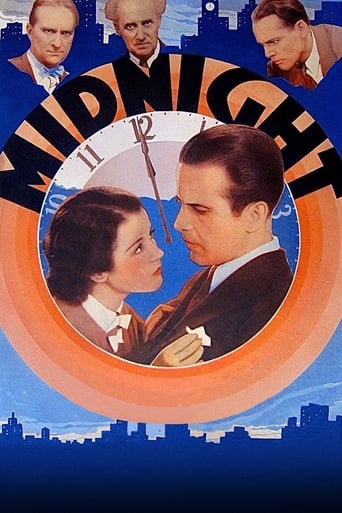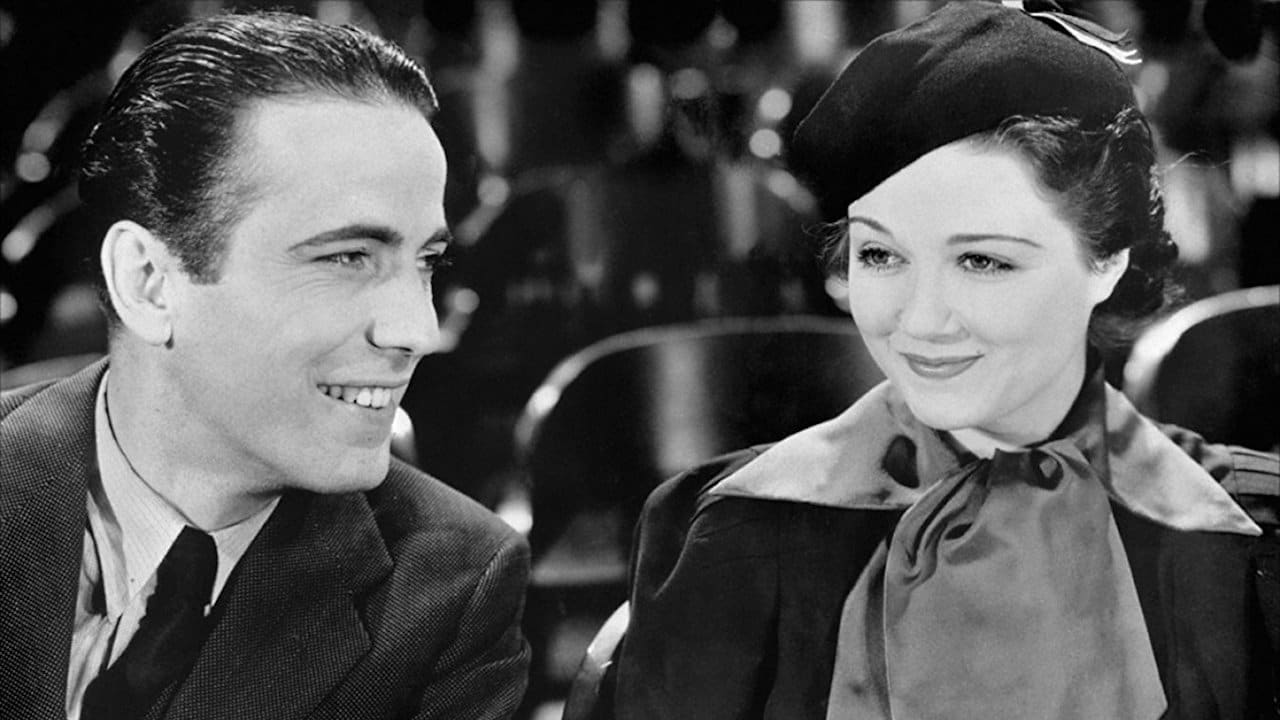mmipyle
I was in a Bogart mood last night, so I put in a film I've not watched in twenty-five years, at least. I recently bought "Midnight" (1934) (and the original title!) from Grapevine because it's the original release print and not the re-release under the title "Call It Murder" (1947), a print that has been circulating forever in the market. I'd never seen an original print. Trust me, original or re-release, this All Star Pictures produced/Universal Pictures release needs mouth to mouth resuscitation to be watched today. It's got a really superb cast, but they had to have made this one for the money alone. Why else would any of them - INCLUDING THE DIRECTOR!!!!!! - have allowed the credits to misspell their names?? The director, Chester Erskine, shows up nearly immediately as Chester Erskin; then the cast begins and Lynne Overman has his first name spelled without the final "e", too; next is Moffat Johnston as Moffat Johnson; and lastly the well-known character actor Henry O'Neill shows up missing the final "l" in his last name. I guess 'eetl' cost a tad too much to add... Anyway, the premise for this film is decent, but very, very depressing. In some ways, that's the point. A jury for a crime of passion gives the woman who committed the crime the death sentence instead of letting her off. We watch the clock (and all the events that happen with several characters) tick away until the midnight when the execution happens. The foreman of the jury, played by O. P. Heggie, claimed that it was murder because of a technicality based in a question he himself is allowed to ask the "guilty" woman, played by Helen Flint. A lot of people outside of the court don't agree after the verdict is read in court. We see all of this played out against the time to the execution. O. P. Heggie's daughter, and the first name in the cast, is played by Sidney Fox (an actress who is allowed to be called one because she was allowed to be called one - period). She falls - in the meantime - for small time hoodlum, Gar Boni, played by Humphrey Bogart. Others in this cast include Henry Hull (who plays a really sneaky newspaperman), Margaret Wycherly (she was Cagney's "Ma" in "White Heat" - and here she's actually a nice-looking older woman instead of the crone she so often played), Granville Bates, Cora Witherspoon, Katherine Wilson, and actor and future director Richard Whorf. The biggest problem with this film besides direction was a lack of creativity in producing it on film. It's definitely the kind of thing that belongs almost exclusively on stage - or a half-hour TV show during the 1950's, done live. The editing is non-existent. Time back and forth could have been done, rather than the stagnant linear movement forward which drags on and on and on. Thankfully, after a full 76 minutes, the program ends. By the way, Bogie himself has some razzmatazz in his voice, but even he's boring... Molasses that isn't sweet isn't sweet, people. Best thing in the picture is Lynne Overman. That's not surprising. He's always rich in character. Here he's a shiftless, no-good husband of Katherine Wilson who'd rather be rolling dice or the like. I know, who's Katherine Wilson? I don't know, either, so quit asking!
John Esche
MIDNIGHT (reissued by "Guaranteed Pictures" in 1947 as CALL IT MURDER with eighth billed Humphrey Bogart - now famous - elevated to top billing for his supporting role) was originally filmed at the Biograph Studios in Queens, New York, for Universal Pictures, based on a Theatre Guild production of the same name (but called IN THE MEANTIME during its tryout tour).While the stage production disappointed the critics and was not extended beyond its initial subscription run (48 perf., December 29, 1930 - Feb. 1931 at the Guild Theatre), Claire and Paul Sifton's examination of the flaws in the idea that "the law is the law" regardless of justice or tempering with mercy was interesting enough to justify Universal's committing a cast from the top of their second tier to turning out a decent "programmer" to fill the demand for films to keep the screens they controlled occupied between their major releases and training stars in the making (like Bogart and Sidney Fox).The original play concerned the foreman of a jury, a man named Edward Weldon (O.P. Heggie on screen), which had condemned a woman for the murder of a man who was leaving her - only to find, two acts later, his daughter (Fox) in a similar situation.Director Chester Erskine (at the start of a career which would see well remembered work on such "A" releases as THE EGG AND I, ALL MY SONS and ANDROCLES AND THE LION, working as director, writer and producer for another 40 years), while unable to produce the figurative "silk purse" out of a possible "sow's ear" of a melodrama, opened up the play, originally set only in the Weldon living room, with excellent - and given the period, surprisingly sophisticated - crosscutting between the condemned woman, the daughter's developing affair and the moral quandary around the Weldon himself.If the 30's structure of the argument may strike many as dated today, and the "deus ex machina" solution to one of Weldon's problems too pat to be genuinely satisfying, they probably are - but the elder Weldon's overly strict, unbending interpretation of his moral and civic obligations is hardly unknown today as an excuse for lack of thought or bigotry. A remake with more "modern" technique might indeed be well received, but the implicit melodrama would be just as blatant.While Humphrey Bogart's role is a relatively small one (although it is woven through most of the film), it makes for legitimately fascinating viewing as a transitional role for the handsome actor who had been playing stage juveniles. He had had 15 Broadway roles in the 12 years - and 9 films in the three years - before making this film, but would only have two more Broadway credits afterward (but 66 films). His Gar Boni in MIDNIGHT is very well done in a more modern style than many around him (see the similar effect the young Helen Hayes achieved with the same then "fresh" realistic style in 1932's FAREWELL TO ARMS) before finding the "world weary" persona that won career-making acclaim for his "Duke Mantee" opposite Leslie Howard on Broadway and screen just two years later.It may be of some interest that on stage, the supporting role of Arthur Weldon (played in the film by future director Richard Whorf) was created by actor/playwright Clifford Odets. Finding a good print of MIDNIGHT or even CALL IT MURDER may not be easy, but the search may be worth it. Don't expect a polished "modern" film, and shallow film buffs who don't appreciate history or context will probably hate it, but true film connoisseurs shouldn't miss this one for what IS there.
classicsoncall
It was somewhat comical to see the full screen opening credit given Humphrey Bogart in this re-release version from Guaranteed Pictures. One of the mainstays of the public domain bargain bin, "Call It Murder" provides an early look at the future star in a limited role, which in retrospect could have been played by virtually anyone.Bogey's character is a minor hood named Gar Boni, caught in a predicament that requires him to leave town after getting involved with the daughter of a jury foreman. We don't find out much about his circumstances but they must be grim, an accomplice responds to Gar's penchant for baseball by asking - "Hey kid, they got any bulletproof grandstands out there?" Throughout the trial, Stella Weldon (Sidney Fox) finds herself at odds with her father's role; he was able to steer the jury to find Ethel Saxon (Helen Flint) guilty of murder by virtue of pre-meditation. The entire film is used to explore Weldon's (O.P. Heggie) resolve with the verdict in the face of public disapproval and mounting controversy over Saxon's execution. It provides the set up for his own daughter's circumstances when she pulls the trigger on Gar, a case of the jilted lover lashing out. Did she have time to think about what she would do, or was it an instinctive crime of passion?Overall, the film could have used better pacing, there were moments that seemed to drag incessantly. I was intrigued though by an interesting use of camera angles in a scene where Gar's departure from Stella is reflected in a mirror at the bottom of the staircase in the Weldon home. The picture might also have gotten more mileage out of the device of cutting between scenes of Weldon's conscience bound pacing with that of the doomed Saxon in her prison cell. The idea was a good one but was buried too quickly to make the point it could have.In it's way, the movie is a viable pre-cursor to the noir films of the following decade, it's dark and brooding, with the female lead encountering desperation as her payoff, whether or not D.A. Plunkett (Moffat Johnston) succeeds in digging her out of a mess. Her father meanwhile is left to wrestle his own conscience over the quandary of whether justice for one ought to be the basis of justice for all. An interesting moral dilemma as well as a legal one, the story works to confound us all if faced with the same situation.
abbyart
One must judge this movie along-side its contemporaries. It is an outstanding example of the numerous "women with law problems" pictures of the Thirties. It avoids the sentimentality and masochistic suffering that the female lead predictably, and monotonously undergoes. Instead of a simple morality tale, with the focus on a single character's torment, we are presented with one of the earliest examples of Noir that I know, complete with dark despair, pessimism, and cynicism. The Law, in-laws, ambitious DAs, insensitive fourflushers and amoral bourgeois relatives, and an ambiguously moral reporter all serve to subvert the movie's latent sentimentality and cause us to question our moral bearings. Bogart is excellent in his brief role, but it is ridiculous to judge this movie by his screen time. All the acting is excellent (save Ms. Fox?) and the casting superb. The direction is inventive, especially considering the confining main set, with many startling close-ups, camera angles, and tableaux. Consider this movie in terms of the original "Chicago" (the play, 1927), its remake as the movie Roxie Hart (W. Wellman, 1942) and "Chicago," 2002. You'll see it has a lot to add to this theme, and is worthy of consideration in its own right.


 AD
AD



